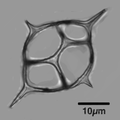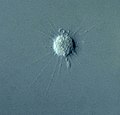Axodine
| Axodines | |
|---|---|

| |
| An actinophryid | |
| Scientific classification | |
| Domain: | Eukaryota |
| Clade: | Diaphoretickes |
| Clade: | SAR |
| Clade: | Stramenopiles |
| Phylum: | Gyrista |
| Subphylum: | Ochrophytina |
| Class: | Dictyochophyceae |
| Subclass: | Pedinellia Cavalier-Smith 1986 stat. nov. 2017[1] |
| Genera | |
| Synonyms | |
The axodines are a group of unicellular
The Axodine grouping was unusual in breaking with the traditions of botanical and protozoological taxonomy to include the actinophryid heliozoa as part of the lineage that also contained the
Characteristics
The name points to a character that is deemed to be synapomorphic for the group: that is the microtubular arrays that extend from the surface of the nucleus. Many flagellated forms have a single emergent flagellum, that lacks the root structure found in related chrysophytes.
-
Siliceous skeleton of the dictyochid flagellate, Dictyocha fibula
-
Actinophrys sol, living heliozoon
-
Actinomonas - heterotrophic flagellate with single flagellum and stiff arms
-
Ciliophrys infusionum, living flagellate
Classification and history


The traditional botanical treatment of the group follows
Order Dictyochales
The most notable group is the
Order Pedinellales
Most other axodines form a group variously called the pedinellids.
Order Rhizochromulinales
In addition to the silicoflagellates and actinodines, the marine amoeboid Rhizochromulina marina is included here based on the structure of its zoospores. It is considered closer to the latter group than the former.
References
- PMID 28875267.
- .
- ^ a b Mikrjukov KA, Patterson DJ (1 February 2001). "Taxonomy and phylogeny of Heliozoa. III. Actinophryids" (PDF). Acta Protozoologica. 40 (1): 3–26.
- ISBN 9780521462600. Retrieved 2014-12-12.
- ^ Nikolaev, S.I., Berney, C., Fahrni, J., Bolivar, I.,Polet, S., Mylnikov, A.P., Aleshin, V.V., Petrov, N. B., Pawlowski, J. 2004. The twilight of Heliozoa and rise of Rhizaria, an emerging supergroup of amoeboid eukaryotes. Proceedings of the National Academy of Sciences 101 (21) 8066-8071; DOI: 10.1073/pnas.0308602101
- ^ Patterson, D. J. and Fenchel, T. 1985. Insights into the evolution of heliozoa (Protozoa, Sarcodina) as provided by ultrastructural studies on a new species of flagellate from the genus Pteridomonas. Biol. J. Linn. Soc. 34: 381-403
- ^ Patterson, D. J. 1986. The actinophryid heliozoa (Sarcodina, Actinopoda) as chromophytes. pp. 49 - 67 in Kristiansen, J. & Anderson, R. A. Chrysophytes: aspects and problems, Cambridge University Press, Cambridge & New York.
- ^ Smith, R. McK. & Patterson, D. J. 1986. Analyses of heliozoan inter-relationships: an example of the potentials and limitations of the ultrastructural approaches to the study of protistan phylogeny. Proc. R. Soc. Lond. 227:325 - 366.





